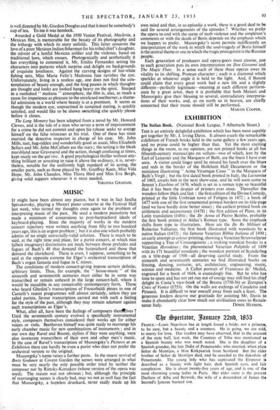EXHIBITION '
The Italian Book. (National Book League, 7 Albemarle Street.) /
Tins is an entirely delightful exhibition which has been most capably got together by Mr. J. Irving Davis. It almost excels the remarkable exhibition of French books held in the same gallery a few years ago, and no praise could be higher than that. Yet the most exciting things in the room, in my opinion, are not printed books at all but fifteenth-century manuscripts on vellum—two of which, lent by the Earl of Leicester and the Marquess of Bath, are the finest I have ever seen. A visitor could linger until he missed his lunch over the blues and reds in the border of the Holltham Hall Decameron or the miniature illustrating" Arma Virumque Cano "in the Marquess of Bath's Virgil ; but the first dated book printed in Italy, the Lactantius of 1465, awaits him in the next show-case, and he will soon come to Jenson's Eusebius of 1470, which is set in a roman type so beautiful that it has been the despair of printers ever since. Thereafter the wonders follow thick and fast : the first edition of the Divine Comedy, printed at the little Umbrian town of Foligno in 1472; a book of 1477 with one of the first ornamental printed borders on its title-page (and we have hardly done better since) ; the earliest printed book on arithmetic and accountancy (1478) ; the first edition of Plato, in its Latin translation (1484) ; the De Aetna of Pietro Bembo, probably the first book printed in Aldus's Roman type. Soon the emphasis shifts from type to illustration. Here are the De Re Militari of Robertus Valturius, the first book illustrated with woodcuts by a native Italian (1472) ; the famous Venetian Bibbia Italiana of 1490; an early attempt at colour-printing, showing a Venetian Struwwelpeter supporting a Tree of Consanguinity ; a striking woodcut border in a Venetian Herodotus ; the phenomenal Venetian Po/iphi/o of 1499 with its 171 beautiful woodcuts ; the woodcut portrait of Scanderbeg on a title-page of 1508—all deserving careful study. From the sixteenth and seventeenth centuries we find illustrated books on fencing, dancing, costume, art, architecture, engineering, music, science and medicine. A Callot portrait of Francesco de' Medici, engraved for a book of 1614, is exceedingly fine. But he who has time to spare and has not yet run out of energy may still find his chief delight in Costa's view-book of the Brenta (1750-56) or Zompini's Cries of Venice (1753). On the walls are etchings of Canaletto and Piranesi. It is difficult to tear oneself away from such a feast. The generous lenders deserve our gratitude for assisting Mr. Davis to make it abundantly clear how much our civilisation owes to Renais-


































 Previous page
Previous page